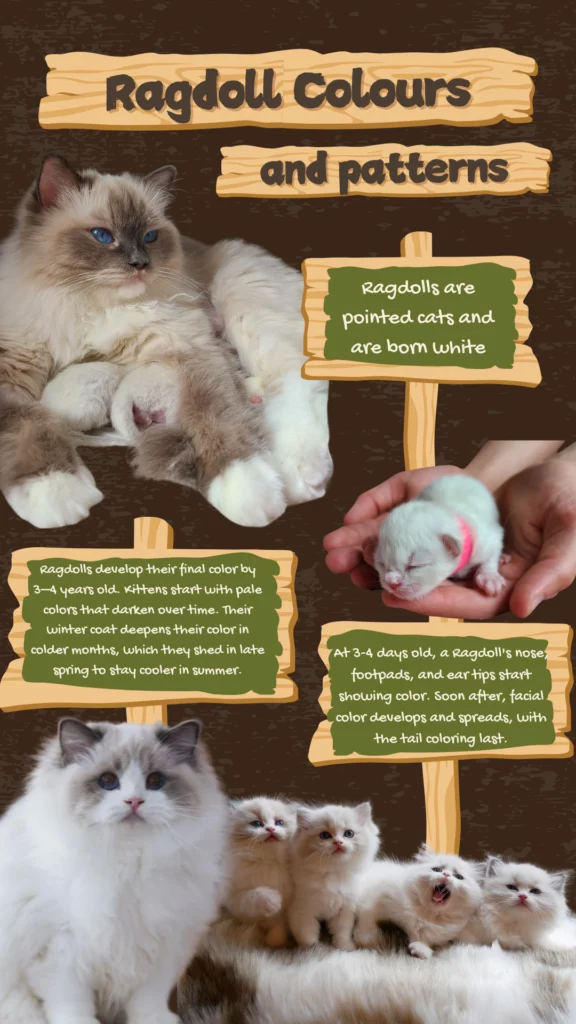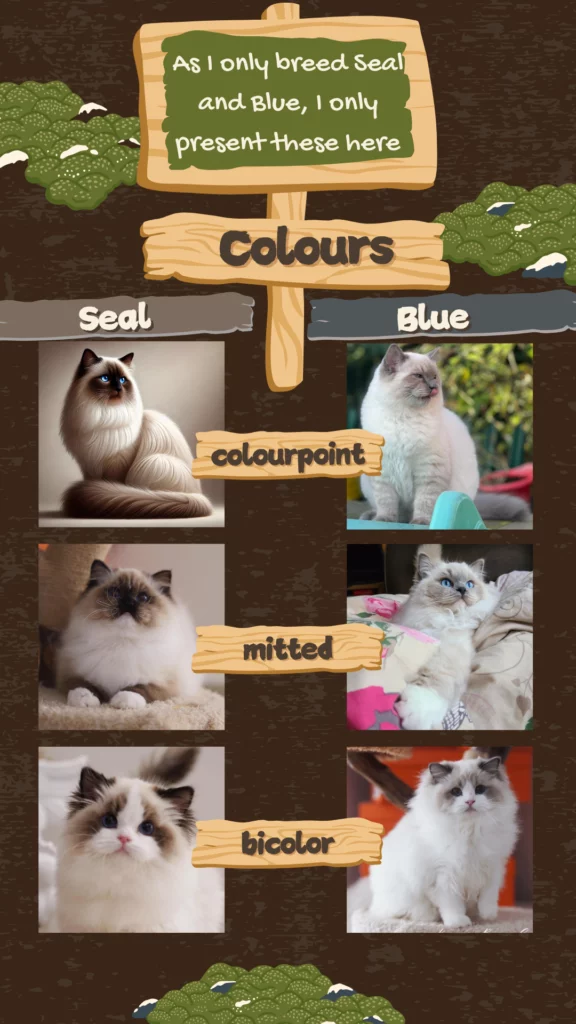About the Breed
The Origin of the Ragdoll
A Breed Born to Love
The Ragdoll is a relatively young but extraordinary breed with a story as unique as its personality. It all began in the 1960s in Riverside, California, where a Persian-type white cat named Josephine gave birth to a litter of unusually gentle, affectionate kittens. These kittens had a remarkable temperament, they would relax completely when picked up, almost like a soft cloth doll, which inspired the name “Ragdoll.”
Ann Baker, a dedicated breeder, recognized something truly special in Josephine’s offspring. Through selective breeding, she developed a line of large, loving cats with striking blue eyes, silky semi-long coats, and a temperament unlike any other. Calm, affectionate, and deeply people-oriented, Ragdolls were created to be the perfect companion.
Over time, the breed became known not only for its beauty, but for its wonderful nature. Ragdolls adore human company, follow their people from room to room, and form deep, trusting bonds. They’re often described as “dog-like” in their loyalty and gentle curiosity.
Today, Ragdolls are beloved worldwide. From their humble beginnings in California to their recognition by top international cat associations, the Ragdoll remains one of the most affectionate and family-oriented breeds in the world, a true heart cat in every sense.

Ragdoll Breed Standart
Ragdolls are known not only for their affectionate personality, but also for their elegant, doll-like appearance. Here’s a simple overview of what makes this breed so special:
🟦 Size & Body
Ragdolls are one of the largest cat breeds. They grow slowly and reach full size between 3–4 years of age.
They have a strong and muscular body, broad chest, and long, fluffy tail. Males are usually larger than females.
💙 Eyes
All Ragdolls have striking blue eyes — the deeper the blue, the more desired. Eye shape is oval and expressive.
🐱 Head & Face
The head is broad and gently rounded, with a soft facial expression. The nose has a gentle curve, and the chin is strong and well-developed.
Their ears are medium-sized and slightly tilted forward.
✨ Coat
Ragdolls have a semi-long, silky coat that’s soft and easy to care for. Unlike some longhaired breeds, their coat doesn’t mat easily.
The fur is shorter around the shoulders and longer like a “ruff” around the neck and on the back legs.
🎨 Colours & Patterns
All Ragdolls are born white and develop their colour over time. They are pointed cats, which means their ears, face, tail and legs are darker than the rest of the body.
There are 3 main patterns:
Colorpoint – no white markings, just darker points.
Mitted – same as colorpoint, but with white “mittens” on front paws and white boots on back legs, plus a white chin and belly stripe.
Bicolor – an inverted white “V” on the face, white legs and belly, and a coloured back and tail.
Accepted colours include:
Seal, blue, chocolate, lilac, red, and cream, as well as tortie and lynx versions of each.
🧬 Temperament
Although not part of the breed standard, personality is a huge part of what makes Ragdolls so beloved. They are known for being gentle, relaxed, and people-loving — true companions who enjoy cuddles, follow you from room to room, and often go limp when picked up (just like a ragdoll).

Traditional, European & Chinese Ragdolls
Understanding the subtle beauty of different bloodlines
All 3 categories are purebred Ragdolls and meet the official breed standard. yet over time, different lines have developed their own unique look. These differences are about style and refinement. For example, to achieve deeper blue eyes, breeders selected the cats with the most vivid colour and passed that trait on to their kittens. The same approach was used to develop fluffier coats or bushier tails. each generation carefully shaped by thoughtful breeding.
Here’s a simple guide to help you understand the subtle distinctions between Traditional, European, and Chinese bloodlines:
🐱 Head & Face
Traditional Ragdolls often have a slightly sharper, more angular face.
European Ragdolls tend to show a rounder head with a soft, teddy bear-like look.
Chinese Ragdolls usually have a very round face, a broader muzzle, and the signature adorable “dollface” expression.
👂 Ears
Traditional Ragdolls often have slightly larger ears with more pronounced tips.
European Ragdolls usually have medium-sized, rounded ears that complement their soft facial structure.
Chinese Ragdolls typically have small to medium ears, set wide apart with rounded tips, adding to their sweet, open expression.
🐾 Body Type
Traditional Ragdolls have a balanced, moderate build.
European Ragdolls are often sturdier and chunkier, with strong boning and a solid physique.
Chinese Ragdolls can range in size from small to large. Some have very strong boning and a powerful build, while others, especially those with the very cute dollface look are more delicate and compact in size.
🧶 Coat Texture
Traditional Ragdolls often have a shorter coat that is less silky and fluffy compared to other lines. While still soft, their coat may not have the same luxurious “bunny coat” feel.
European and Chinese Ragdolls have semi-long fur as per the breed standard, but their coat is often silkier, fuller, and softer. Some can be extremely fluffy — like a little cotton cloud — especially around the neck, tail, and hind legs. This luxurious texture is one of the reasons many people fall in love with these lines.
💙 Eye Colour
Ragdoll eye colour ranges from level 1 (light blue) to level 6 (deep sapphire blue):
Traditional Ragdolls: typically have lighter blue eyes (level 1–3).
European Ragdolls: range from medium to deep blue (level 2–5).
Chinese Ragdolls: are known for especially intense, deep blue eyes (level 3–6), which are one of their most admired features.
💷 Pet Price (UK)
Traditional Ragdolls: £500–900
European Ragdolls: £1000–1800
Chinese Ragdolls: £1500–2500
Prices vary depending on bloodline, appearance, health testing, and whether the cat was imported. Chinese Ragdolls often involve higher import costs and are rarer in the UK.
✨ Conclusion
Understanding the differences between Ragdoll bloodlines helps you choose the companion that best matches your preferences. Whether you love the elegance of a Traditional Ragdoll, the sturdy charm of a European line, or the rare and captivating beauty of a Chinese Ragdoll, every one of them shares the same sweet, affectionate temperament.
No matter which line you choose, your Ragdoll will be more than just beautiful. You’ll welcome a loyal, loving companion into your home, one that will bring calm, affection, and warmth to your life for many years to come.



Colors and Patterns
🎨 Ragdoll Colours
Ragdoll cats come in a stunning variety of colours, each with its own soft charm. These colours appear on their points — the ears, face, paws, and tail — while the body remains a lighter shade.
Here are the main Ragdoll colours:
Seal – A rich, deep brown with warm, dark points.
Chocolate – A warm, milk-chocolate tone with softer contrast.
Blue – A cool, bluish-grey colour with soft grey-blue points.
Lilac – A delicate, pale lavender-grey — the lightest of the Ragdoll colours.
Red – A vibrant, reddish-gold or flame tone on the points.
Cream – A soft, pale peach or ivory tone with gentle contrast.
Each Ragdoll colour can appear in solid or lynx (tabby) patterns, and some are also combined with tortie (tortoiseshell) markings.







